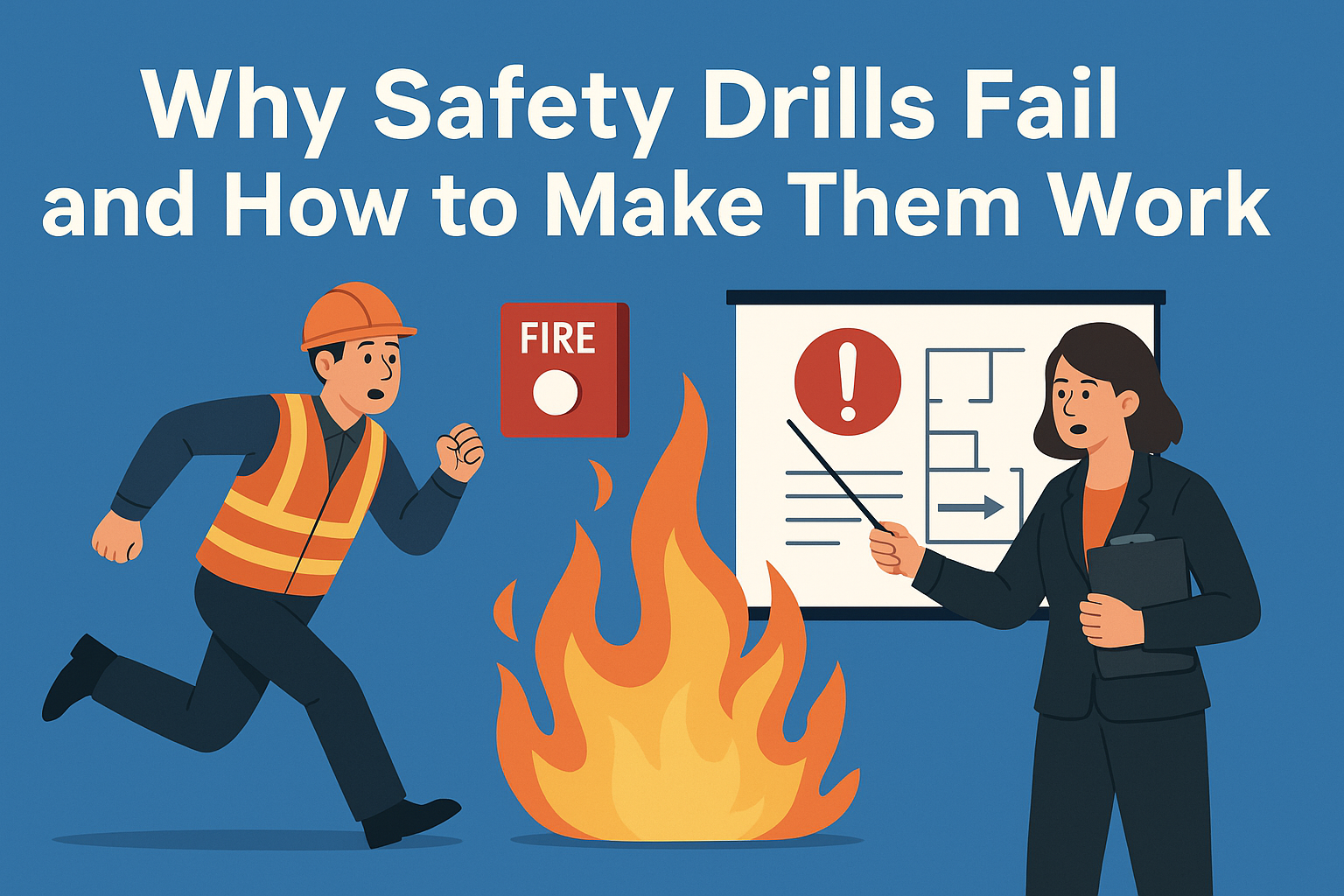Why Safety Drills Fail and How to Make Them Work is a topic that cuts to the core of workplace emergency preparedness.
Safety drills are designed to prepare employees for real-life emergencies—fires, chemical spills, active threats, or natural disasters. But too often, these drills fall flat. They become checkboxes, time-wasters, or worse—false security.

The difference between a life-saving evacuation and total chaos often comes down to how drills are conducted.
In this article, we examine common reasons why drills fail and provide actionable solutions to make them more effective, realistic, and engaging.
The Purpose of Safety Drills: More Than Just Practice
Safety drills are not just procedural—they are behavioral rehearsals for how people respond in high-pressure situations. They aim to:
- Reduce panic during real emergencies
- Ensure fast, safe evacuations or lockdowns
- Reinforce proper use of equipment (e.g., fire extinguishers, emergency shutoffs)
- Test the effectiveness of emergency plans and communication systems
Unfortunately, many organizations treat them as routine disruptions, missing their potential as powerful learning tools.
Why Safety Drills Fail
Let’s look at the most common reasons why safety drills don’t deliver results.

1. Lack of Realism
If drills don’t mimic the real stresses and obstacles of an emergency, employees won’t be mentally or physically prepared.
- Evacuating in perfect weather doesn’t prepare teams for winter storms.
- Fake alarms without smoke simulation don’t simulate sensory overload.
- Practicing only in daylight ignores after-hours conditions.
2. No Clear Objectives
Drills often lack specific goals such as:
- Time to evacuate
- Communication effectiveness
- Response time to muster points
Without benchmarks, it’s hard to measure success—or improve.
3. No Follow-Up or Feedback
A drill without post-analysis is a missed opportunity. Employees may not know what they did wrong—or right.
- Was anyone left behind?
- Were emergency exits blocked?
- Did the communication system fail?
4. Poor Engagement
When workers aren’t informed or trained properly:
- They treat drills like a joke or break.
- Supervisors don’t take leadership roles.
- Teams act confused instead of coordinated.
This can lead to chaos during a real event.
5. Repetition Without Variation
Running the same drill over and over breeds complacency. Employees memorize the motions but don’t learn to adapt.
Emergencies are unpredictable—your drills should reflect that.
How to Make Safety Drills Work
To make your drills effective and meaningful, follow these proven strategies:

1. Make Drills Scenario-Based
Introduce realistic scenarios:
- Fire in the kitchen
- Active threat in reception
- Power outage during evacuation
- Injured worker blocking an exit
Use role-playing or actors to simulate urgency, confusion, or injury.
2. Train Before You Drill
Provide pre-drill training:
- How to respond
- Where to go
- What to bring
- Who to report to
Empowered employees respond faster and smarter.
3. Surprise Drills With Structure
While regulatory drills should be scheduled, unannounced drills test true preparedness. Combine them with clear post-drill analysis to identify gaps.
Make sure to:
- Time the response
- Assign observers
- Capture video or notes
4. Use Technology
Modern tools improve drills:
- Mass notification apps for lockdown or evacuation alerts
- Digital mustering tools to check attendance
- Drones or cameras to monitor drill execution
This enhances documentation and helps in real-time assessment.
5. Conduct Multi-Agency Drills
Involve local fire departments, EMS, or police in larger-scale drills. This ensures:
- Coordinated response efforts
- Familiarity with your site
- Faster aid during real events
Post-Drill Debriefing: Turning Practice into Performance
A debrief session should be mandatory after every drill. Ask:
- What worked well?
- What caused delays?
- Were communications effective?
- Did all teams respond appropriately?
- What would you do differently next time?
Include input from all levels, from line workers to safety officers. Log your findings and revise your emergency plans accordingly.
Safety Drill Metrics: What to Track
| Metric | Why It Matters |
|---|---|
| Evacuation Time | Indicates speed and efficiency |
| Muster Point Attendance | Identifies missing or delayed workers |
| Communication Speed | Tests alert system performance |
| Role Clarity | Confirms leadership understanding |
| Compliance Rate | Measures participation and accuracy |
Use these metrics to create scorecards and compare performance across different drills and departments.
Real Example: What a “Failed” Drill Taught a Manufacturing Plant
At a Canadian metalworks facility, a fire drill revealed a dangerous flaw: several workers evacuated into the path of delivery trucks because their usual route was blocked. The drill forced the company to rethink emergency signage and add training for alternate exits.
A “failed” drill became a life-saving adjustment.
Final Thoughts
Why Safety Drills Fail and How to Make Them Work comes down to intention, design, and follow-up. When done right, drills aren’t just regulatory requirements—they’re strategic tools that can save lives and improve organizational resilience.
Every drill should aim to:
- Educate, not just evacuate.
- Reveal, not just rehearse.
- Improve, not just inform.
Turn every drill into a data-rich, empowering exercise for your team—because in a real emergency, there are no second chances.


No comments yet